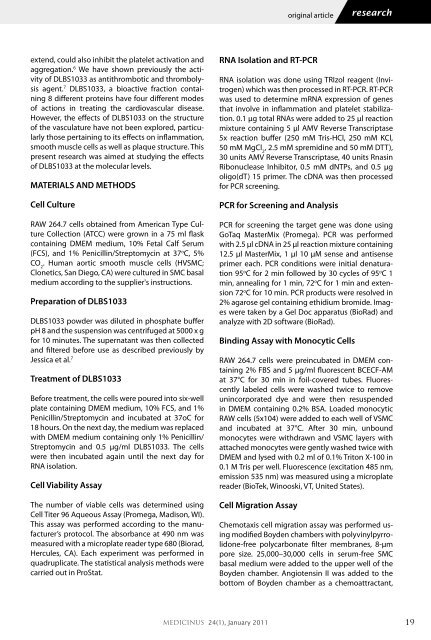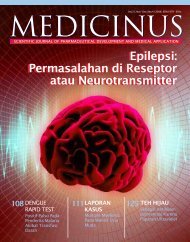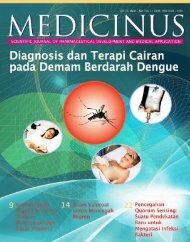Medicinus - Dexa Medica
Medicinus - Dexa Medica
Medicinus - Dexa Medica
Create successful ePaper yourself
Turn your PDF publications into a flip-book with our unique Google optimized e-Paper software.
extend, could also inhibit the platelet activation and<br />
aggregation. 6 We have shown previously the activity<br />
of DLBS1033 as antithrombotic and thrombolysis<br />
agent. 7 DLBS1033, a bioactive fraction containing<br />
8 different proteins have four different modes<br />
of actions in treating the cardiovascular disease.<br />
However, the effects of DLBS1033 on the structure<br />
of the vasculature have not been explored, particularly<br />
those pertaining to its effects on inflammation,<br />
smooth muscle cells as well as plaque structure. This<br />
present research was aimed at studying the effects<br />
of DLBS1033 at the molecular levels.<br />
MATERIALS AND METHODS<br />
Cell Culture<br />
RAW 264.7 cells obtained from American Type Culture<br />
Collection (ATCC) were grown in a 75 ml flask<br />
containing DMEM medium, 10% Fetal Calf Serum<br />
(FCS), and 1% Penicillin/Streptomycin at 37 o C, 5%<br />
CO 2 . Human aortic smooth muscle cells (HVSMC;<br />
Clonetics, San Diego, CA) were cultured in SMC basal<br />
medium according to the supplier's instructions.<br />
Preparation of DLBS1033<br />
DLBS1033 powder was diluted in phosphate buffer<br />
pH 8 and the suspension was centrifuged at 5000 x g<br />
for 10 minutes. The supernatant was then collected<br />
and filtered before use as described previously by<br />
Jessica et al. 7<br />
Treatment of DLBS1033<br />
Before treatment, the cells were poured into six-well<br />
plate containing DMEM medium, 10% FCS, and 1%<br />
Penicillin/Streptomycin and incubated at 37oC for<br />
18 hours. On the next day, the medium was replaced<br />
with DMEM medium containing only 1% Penicillin/<br />
Streptomycin and 0.5 μg/ml DLBS1033. The cells<br />
were then incubated again until the next day for<br />
RNA isolation.<br />
Cell Viability Assay<br />
The number of viable cells was determined using<br />
Cell Titer 96 Aqueous Assay (Promega, Madison, WI).<br />
This assay was performed according to the manufacturer’s<br />
protocol. The absorbance at 490 nm was<br />
measured with a microplate reader type 680 (Biorad,<br />
Hercules, CA). Each experiment was performed in<br />
quadruplicate. The statistical analysis methods were<br />
carried out in ProStat.<br />
RNA Isolation and RT-PCR<br />
RNA isolation was done using TRIzol reagent (Invitrogen)<br />
which was then processed in RT-PCR. RT-PCR<br />
was used to determine mRNA expression of genes<br />
that involve in inflammation and platelet stabilization.<br />
0.1 μg total RNAs were added to 25 μl reaction<br />
mixture containing 5 μl AMV Reverse Transcriptase<br />
5x reaction buffer (250 mM Tris-HCl, 250 mM KCl,<br />
50 mM MgCl 2 , 2.5 mM spremidine and 50 mM DTT),<br />
30 units AMV Reverse Transcriptase, 40 units Rnasin<br />
Ribonuclease Inhibitor, 0.5 mM dNTPs, and 0.5 μg<br />
oligo(dT) 15 primer. The cDNA was then processed<br />
for PCR screening.<br />
PCR for Screening and Analysis<br />
PCR for screening the target gene was done using<br />
GoTaq MasterMix (Promega). PCR was performed<br />
with 2.5 μl cDNA in 25 μl reaction mixture containing<br />
12.5 μl MasterMix, 1 μl 10 μM sense and antisense<br />
primer each. PCR conditions were initial denaturation<br />
95 o C for 2 min followed by 30 cycles of 95 o C 1<br />
min, annealing for 1 min, 72 o C for 1 min and extension<br />
72 o C for 10 min. PCR products were resolved in<br />
2% agarose gel containing ethidium bromide. Images<br />
were taken by a Gel Doc apparatus (BioRad) and<br />
analyze with 2D software (BioRad).<br />
Binding Assay with Monocytic Cells<br />
RAW 264.7 cells were preincubated in DMEM containing<br />
2% FBS and 5 µg/ml fluorescent BCECF-AM<br />
at 37°C for 30 min in foil-covered tubes. Fluorescently<br />
labeled cells were washed twice to remove<br />
unincorporated dye and were then resuspended<br />
in DMEM containing 0.2% BSA. Loaded monocytic<br />
RAW cells (5x104) were added to each well of VSMC<br />
and incubated at 37°C. After 30 min, unbound<br />
monocytes were withdrawn and VSMC layers with<br />
attached monocytes were gently washed twice with<br />
DMEM and lysed with 0.2 ml of 0.1% Triton X-100 in<br />
0.1 M Tris per well. Fluorescence (excitation 485 nm,<br />
emission 535 nm) was measured using a microplate<br />
reader (BioTek, Winooski, VT, United States).<br />
Cell Migration Assay<br />
original article<br />
research<br />
Chemotaxis cell migration assay was performed using<br />
modified Boyden chambers with polyvinylpyrrolidone-free<br />
polycarbonate filter membranes, 8-μm<br />
pore size. 25,000–30,000 cells in serum-free SMC<br />
basal medium were added to the upper well of the<br />
Boyden chamber. Angiotensin II was added to the<br />
bottom of Boyden chamber as a chemoattractant,<br />
MEDICINUS 24(1), January 2011 19




